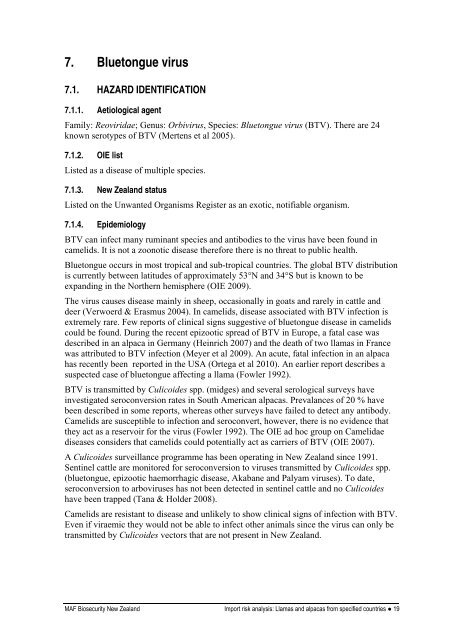Import risk analysis: Llamas (Lama glama) and alpacas (Vicugna ...
Import risk analysis: Llamas (Lama glama) and alpacas (Vicugna ...
Import risk analysis: Llamas (Lama glama) and alpacas (Vicugna ...
You also want an ePaper? Increase the reach of your titles
YUMPU automatically turns print PDFs into web optimized ePapers that Google loves.
7. Bluetongue virus<br />
7.1. HAZARD IDENTIFICATION<br />
7.1.1. Aetiological agent<br />
Family: Reoviridae; Genus: Orbivirus, Species: Bluetongue virus (BTV). There are 24<br />
known serotypes of BTV (Mertens et al 2005).<br />
7.1.2. OIE list<br />
Listed as a disease of multiple species.<br />
7.1.3. New Zeal<strong>and</strong> status<br />
Listed on the Unwanted Organisms Register as an exotic, notifiable organism.<br />
7.1.4. Epidemiology<br />
BTV can infect many ruminant species <strong>and</strong> antibodies to the virus have been found in<br />
camelids. It is not a zoonotic disease therefore there is no threat to public health.<br />
Bluetongue occurs in most tropical <strong>and</strong> sub-tropical countries. The global BTV distribution<br />
is currently between latitudes of approximately 53°N <strong>and</strong> 34°S but is known to be<br />
exp<strong>and</strong>ing in the Northern hemisphere (OIE 2009).<br />
The virus causes disease mainly in sheep, occasionally in goats <strong>and</strong> rarely in cattle <strong>and</strong><br />
deer (Verwoerd & Erasmus 2004). In camelids, disease associated with BTV infection is<br />
extremely rare. Few reports of clinical signs suggestive of bluetongue disease in camelids<br />
could be found. During the recent epizootic spread of BTV in Europe, a fatal case was<br />
described in an alpaca in Germany (Heinrich 2007) <strong>and</strong> the death of two llamas in France<br />
was attributed to BTV infection (Meyer et al 2009). An acute, fatal infection in an alpaca<br />
has recently been reported in the USA (Ortega et al 2010). An earlier report describes a<br />
suspected case of bluetongue affecting a llama (Fowler 1992).<br />
BTV is transmitted by Culicoides spp. (midges) <strong>and</strong> several serological surveys have<br />
investigated seroconversion rates in South American <strong>alpacas</strong>. Prevalances of 20 % have<br />
been described in some reports, whereas other surveys have failed to detect any antibody.<br />
Camelids are susceptible to infection <strong>and</strong> seroconvert, however, there is no evidence that<br />
they act as a reservoir for the virus (Fowler 1992). The OIE ad hoc group on Camelidae<br />
diseases considers that camelids could potentially act as carriers of BTV (OIE 2007).<br />
A Culicoides surveillance programme has been operating in New Zeal<strong>and</strong> since 1991.<br />
Sentinel cattle are monitored for seroconversion to viruses transmitted by Culicoides spp.<br />
(bluetongue, epizootic haemorrhagic disease, Akabane <strong>and</strong> Palyam viruses). To date,<br />
seroconversion to arboviruses has not been detected in sentinel cattle <strong>and</strong> no Culicoides<br />
have been trapped (Tana & Holder 2008).<br />
Camelids are resistant to disease <strong>and</strong> unlikely to show clinical signs of infection with BTV.<br />
Even if viraemic they would not be able to infect other animals since the virus can only be<br />
transmitted by Culicoides vectors that are not present in New Zeal<strong>and</strong>.<br />
MAF Biosecurity New Zeal<strong>and</strong> <strong>Import</strong> <strong>risk</strong> <strong>analysis</strong>: <strong>Llamas</strong> <strong>and</strong> <strong>alpacas</strong> from specified countries ● 19

















